Barely Works Technology -3
cm
back to Barely Works
Technology page
Why 3 cm?
This is one of the main thrusts of the San Bernardino Microwave Society - it
is a way to be part of the club and know what they're doing. Society members
are helpful, have loaner rigs and relevant junk boxes. X-Band (10 GHz) was not
initially high on my intrinsic list, aside from that. Two two-day contest
weekends per year (August - September) plus monthly local activity nights (2100
local Wednesday before SBMS meeting (at least during 2013). W6SZ and others are
interested in conducting weak signal mode tests, such as JT-65, on this and
other microwave bands.
Progress
2013 July 27 SBMS-SDMG Tuneup at Fairview Park,
Costa Mesa where AF6NA (Brian, right) loaned me his "Barstool 3W" 10 GHz rig
(left) for the season. I provide the FT-817 IF (intermediate frequency) rig.
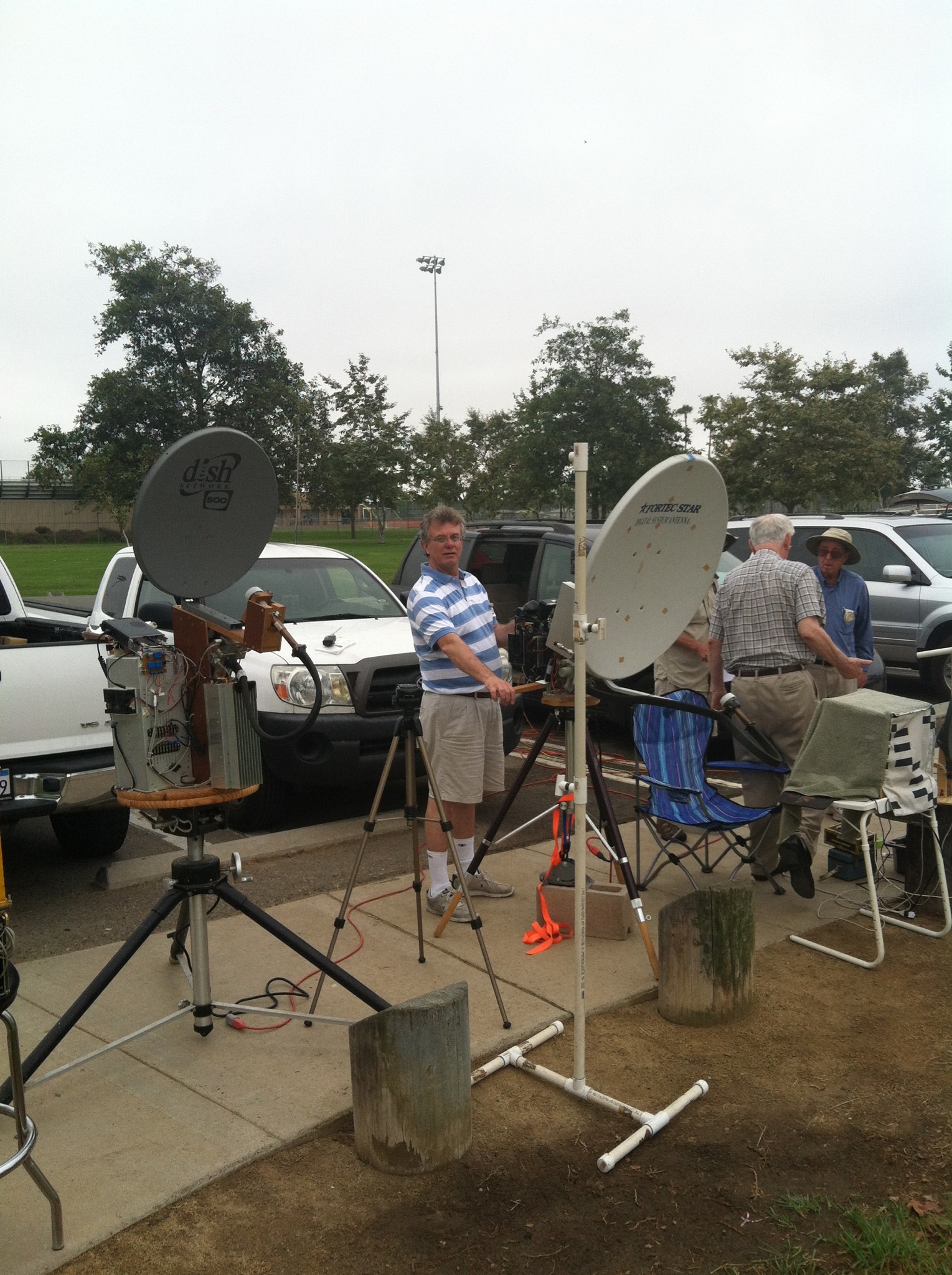
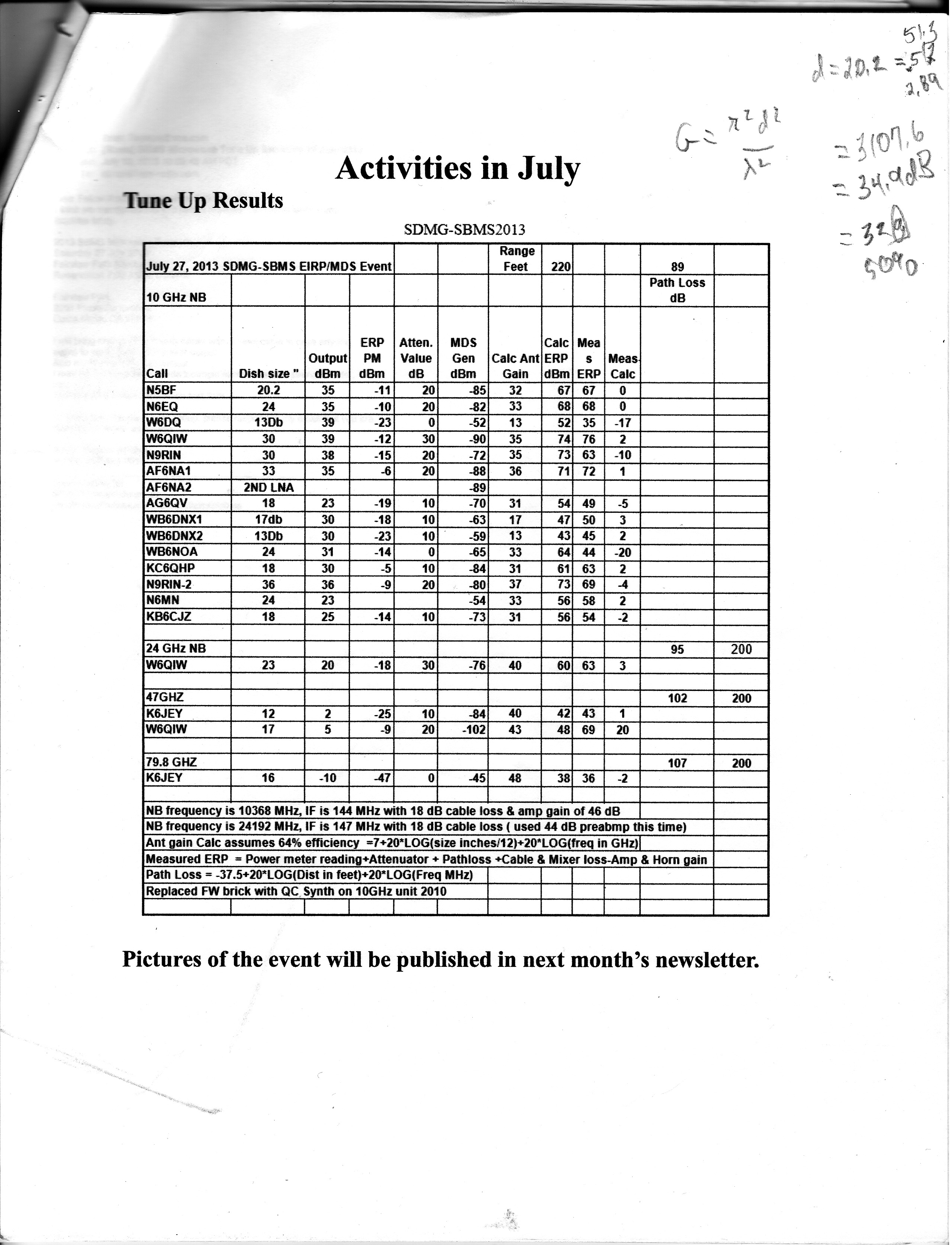
More pictures of the tuneup at http://www.ham-radio.com/sbms/newsletters/2013nwsltrs/09sbms2013.pdf
Then packed it up in the trick and went home. Discovered ways to stow it in
the cab (losing use of the entire right seat in the process) later.

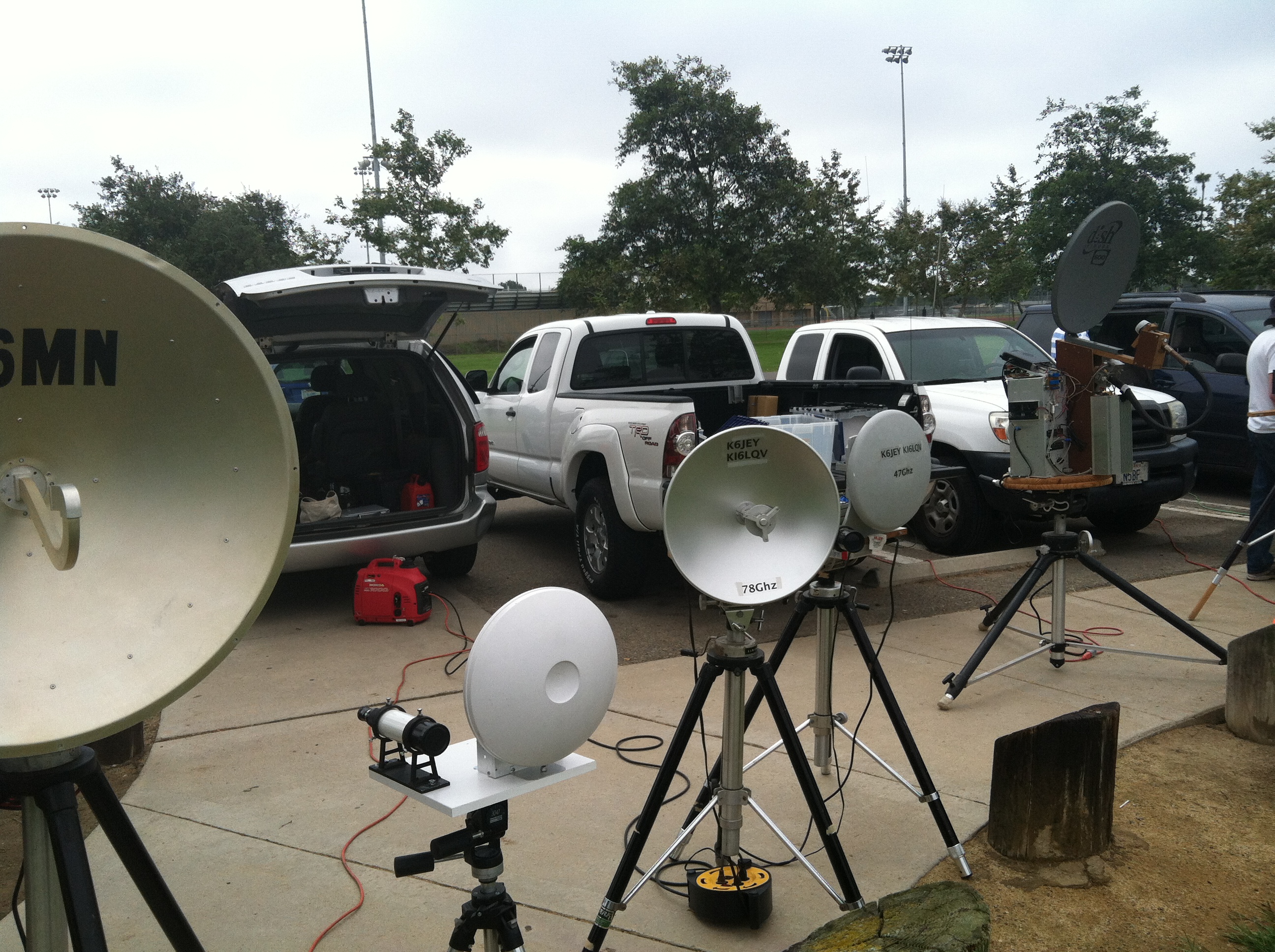
2013 August 1 - SBMS Activity Night
(2100 local, Wednesday evening before "first Thursday" meeting)
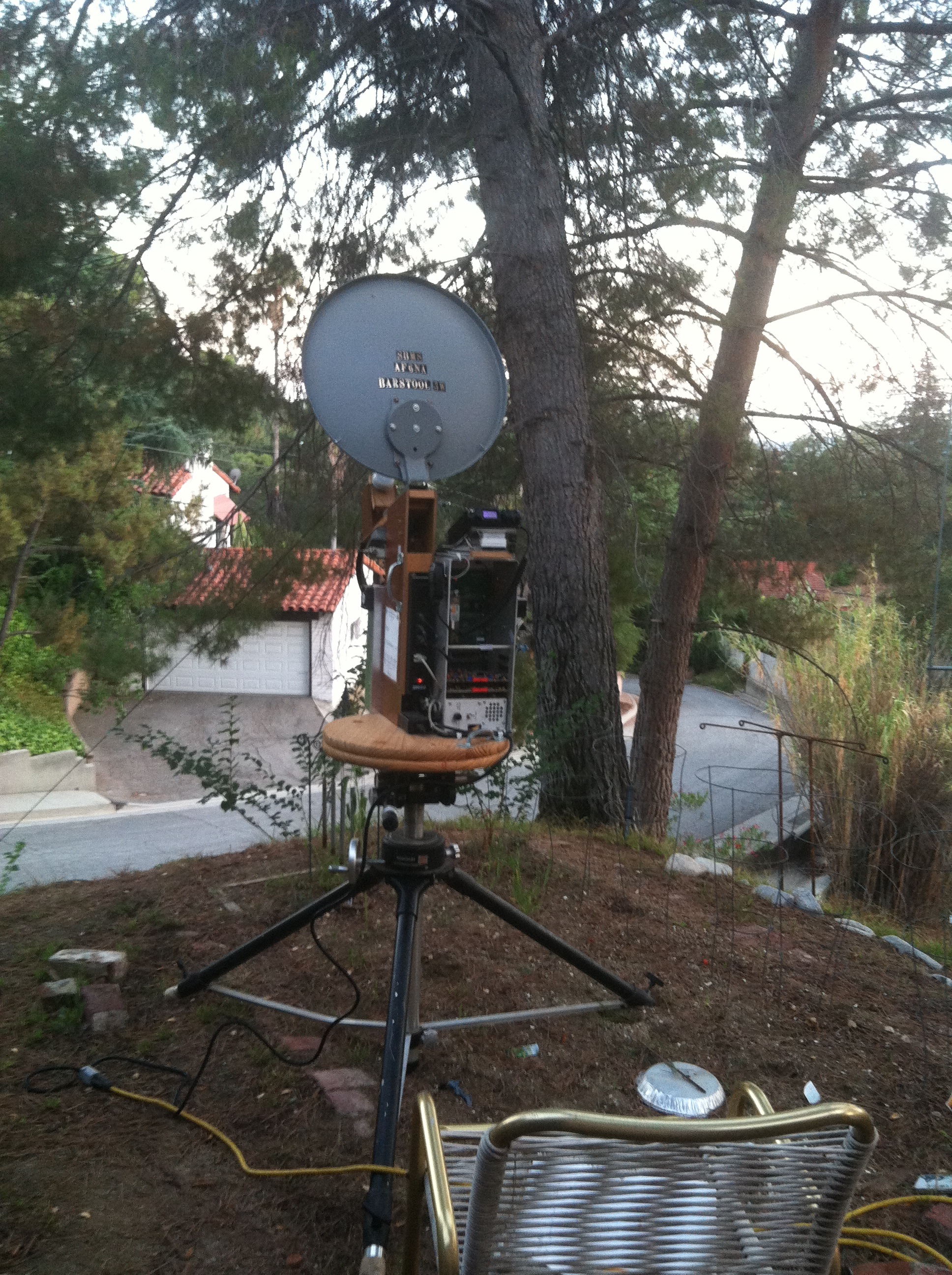

Local beacon on 10.368.300 is S-9. N6CA on Palos Verdes.
Report provided to SBMS reflector:
===
3 cm report from DM04vf: 2013 Aug 1 UTC
0357 WA6CGR 58/53 DM03ut, Dave -- MY FIRST EVER 10 GHz QSO
0400 KC6QHP 58/58 DM03tu, Tony -- MY SECOND EVER 10 GHz QSO
0404 W6DQ 54/53 DM13fu, Dennis (AG6HF's house) -- MY THIRD EVER 10 GHz QSO
not heard but worked by the others: W6SZ
not heard, not worked: WB6DNX (but heard over repeater in Dave's
background)
not heard: 445.5 repeater
not heard: Santiago, Frazier (but did hear Santiago 41 on a reflection Sunday
afternoon)
All peaked in a PV direction, pretty much south from here. Dennis clearly a
reflection off something, all others direct.
5-10 degrees of azimuth pointing makes seven S-units difference, which is "all
or nothing" for most.
0409 round table, general calls by WA6CGR, W6DQ
0440 QNF
10.368.300 N6CA PV beacon - full scale, probably 59+40, heard > S8 in "all"
azimuths +/- 90 degrees
Thanks to the AF6NA "Barstool 3W SBMS" rig. All working as expected.
===
2013 August 10 Test Run with the Barstool at what
would come to be known as Secret Site 2 (DM04vf above La Canada)
This was a trial run to see if I could load, unload, operate, tear down,
load, go home, unload, in preparation for the 8/17/13 10 GHz contest, first
weekend. It was a success as reported, but I did learn that you don't make 10
GHz contacts without significant pre-arranging.
See the San Diego beacon (DM12mq) S9 on 10.368.360.
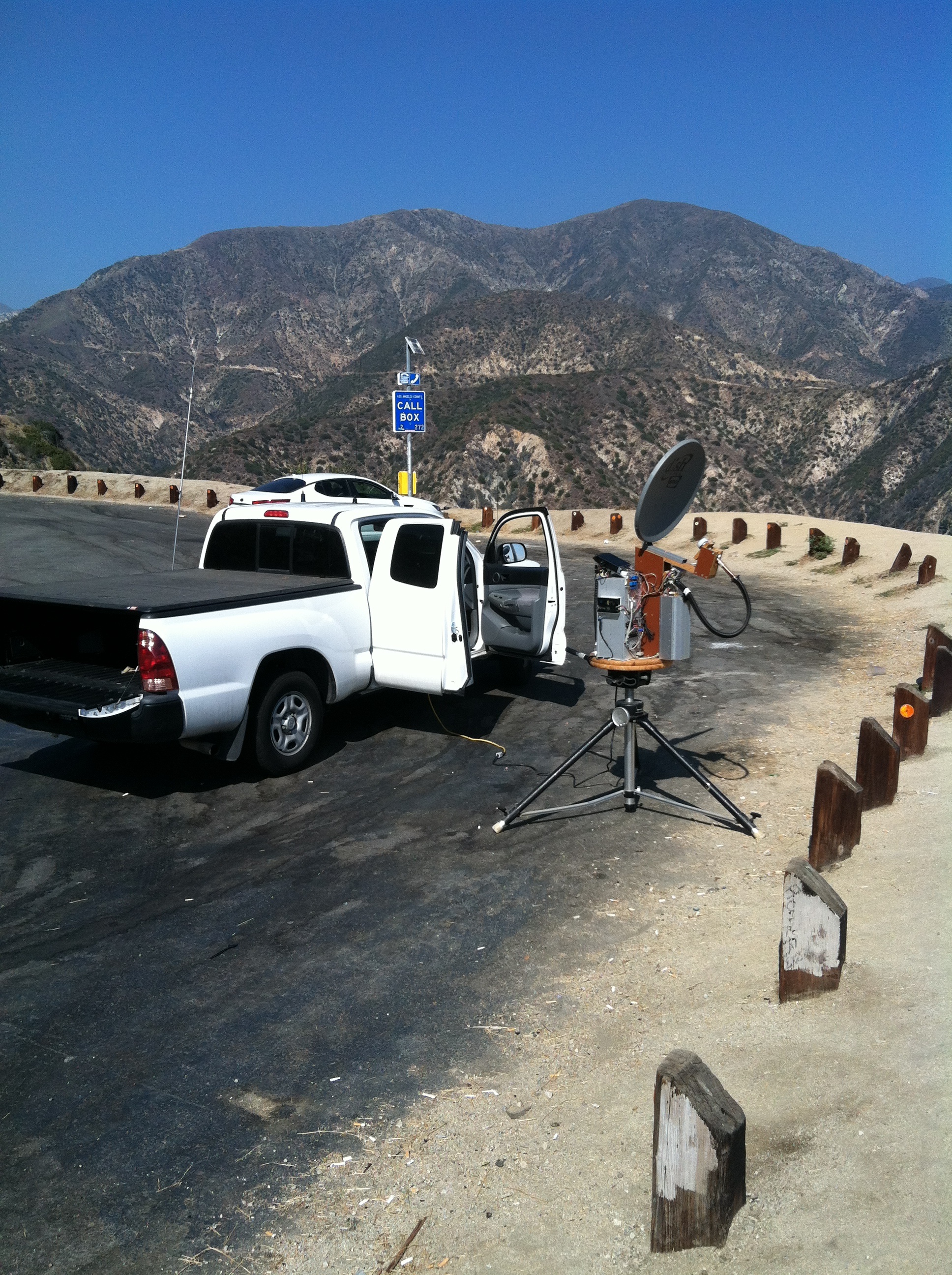
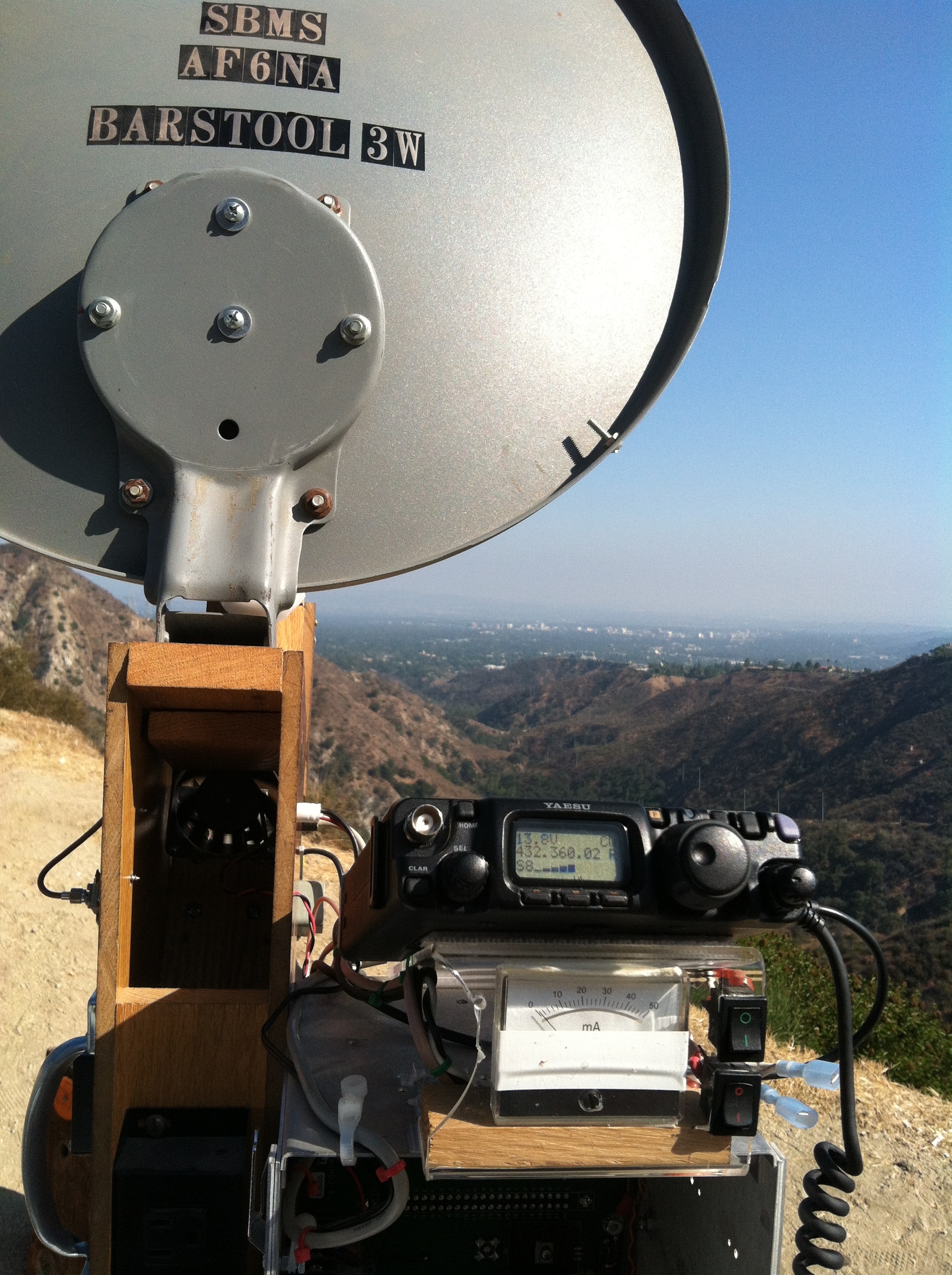
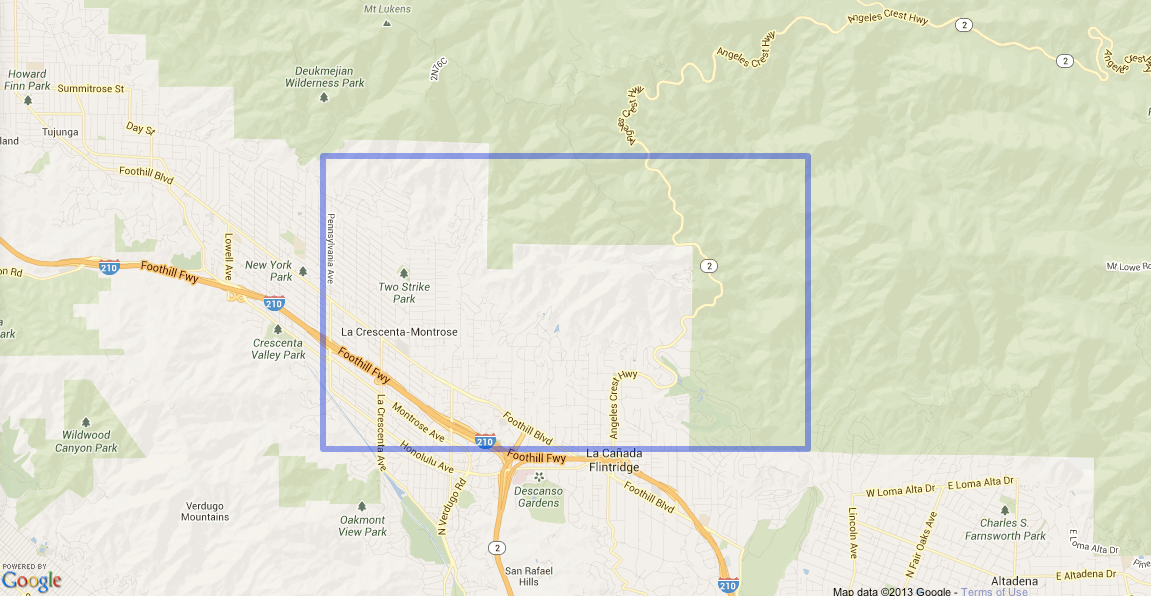
Report:
===
The trial run was a big success. I was able to:
- load up
- drive up
- stop and set up
- get the Barstool to work from truck battery power on an inverter (had the IF
on and heard the Rube (Rubidium Oscillator) warming up for the first time)
- hear the following beacons (plus 10.368 GHz):
.330 59 AF6HP/B Santiago Pk DM13fr
.310 30 N6CA/B DM04ms FZR
.300 59+40 N6CA/B DM03tx PV
.360 58 K6QPV/B DM12mq
.345 nothing heard
So it's hearing really well. I was dialing around in the menus looking for an
RF gain on the 817.
I took azimuth pictures and gave carriers and long USB CQs on .100 in the
Santiago and San Diego directions and gave several CQs in the PV direction.
Nothing heard, but the rig "sounded right" to be transmitting.
Then I was able to, by myself:
- pack up
- drive down
- unload, stow, and report
I was on the air from 1604 to 1650 local.
To my surprise, this turned into a big PR event:
- While I was setting up, gave directions to a taxi cab on how to get to
Switzers up the road, and described what I was doing to three passengers in the
back.
- During operation, "Chris" and "Sergey" came over to watch and ask questions.
I gave them one of the SBMS "what
are we doing here" handouts and answered their questions and showed them
hearing San Diego, Santiago, PV, and Frazier on 10 GHz for fifteen minutes.
They knew Frazier was to the north, "behind that big wall of rock" and were
fascinated by the apparent reflection off Flint or one of the other nearby
peaks (or maybe PV?).
- While I was packing up a group of about eight tourists stopped to take
pictures (of the smoggy scenery, not sweaty me). One asked if I was talking to
aliens, but I said, "no just other people like me." He offered to help me load
the truck, but I told him it didn't count if I didn't suffer the entire ordeal
myself so I could accept no help!
So, I'm more or less ready to go and hoping to work you all next weekend, while
roving up the coast.
===
2013 August 17 - Saturday of the First 10 GHz
Weekend of 2013
Drove to San Diego on the evening of
2013 August 16 and spent the night with my sister.
Morning of 2013 August 17 (Saturday) joined AF6NA on Mt. Soledad for the first
leg of a day of roving up the coast. We ultimately made four stops, moving
more than 10 miles each time as required by the rules for roving.
DM12ju Mt. Soledad


DM13ia Solana Beach, where we both double parked an RV to start.
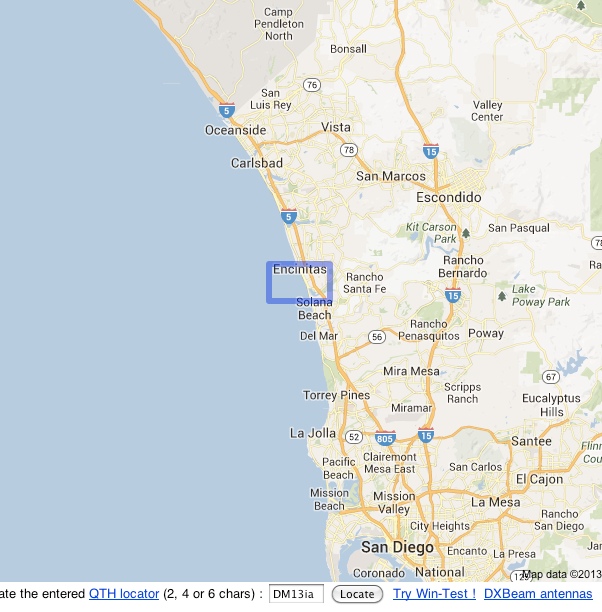
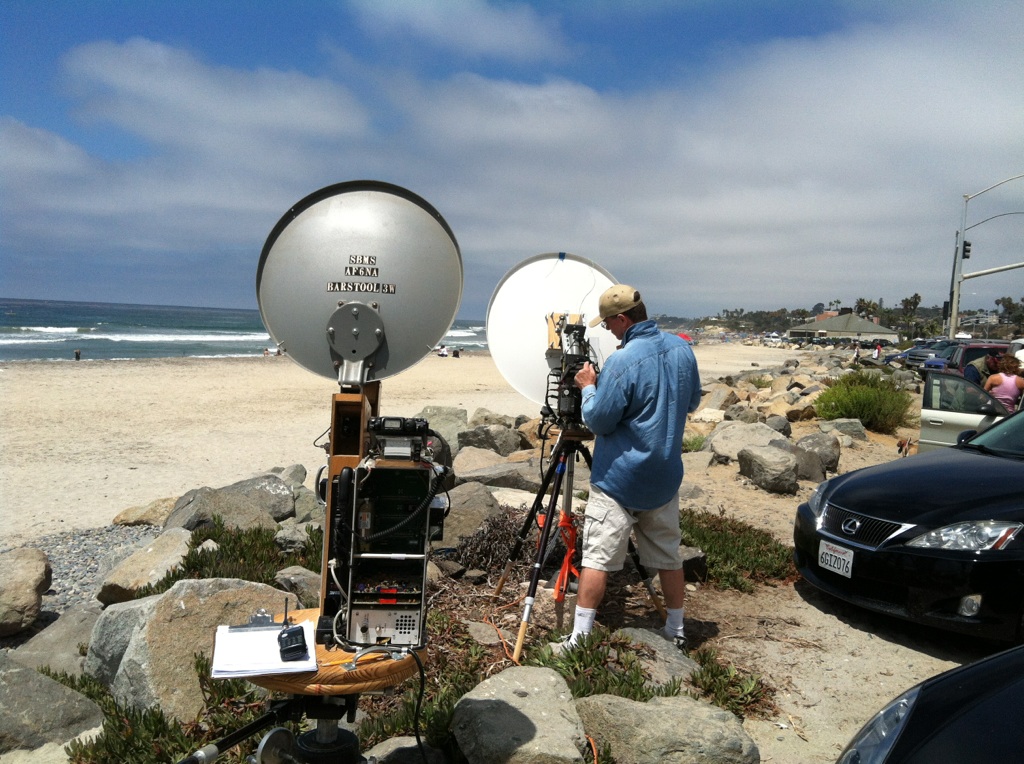
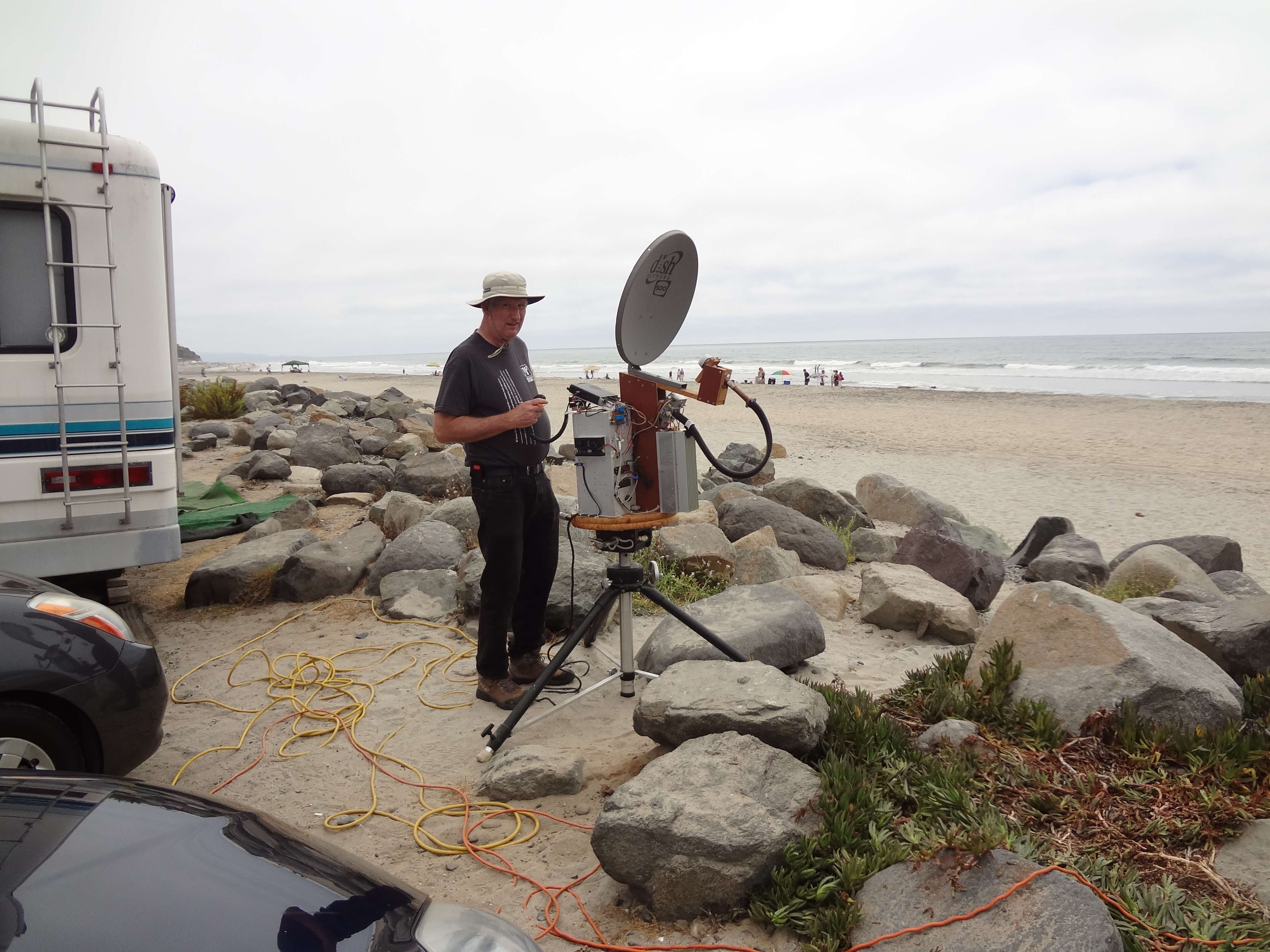

DM13ek Urban San Clemente, where model airplane flying is prohibited and where
I learned to leave my engine running while operating - i.e., had to be jumped
off.
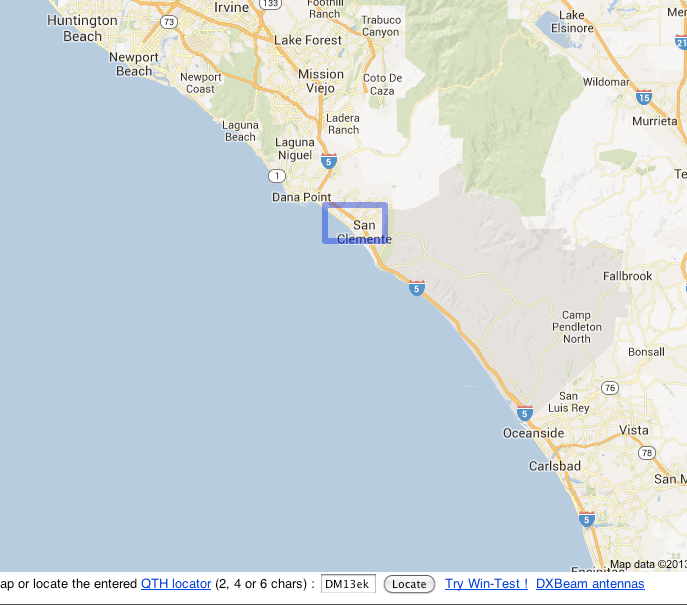
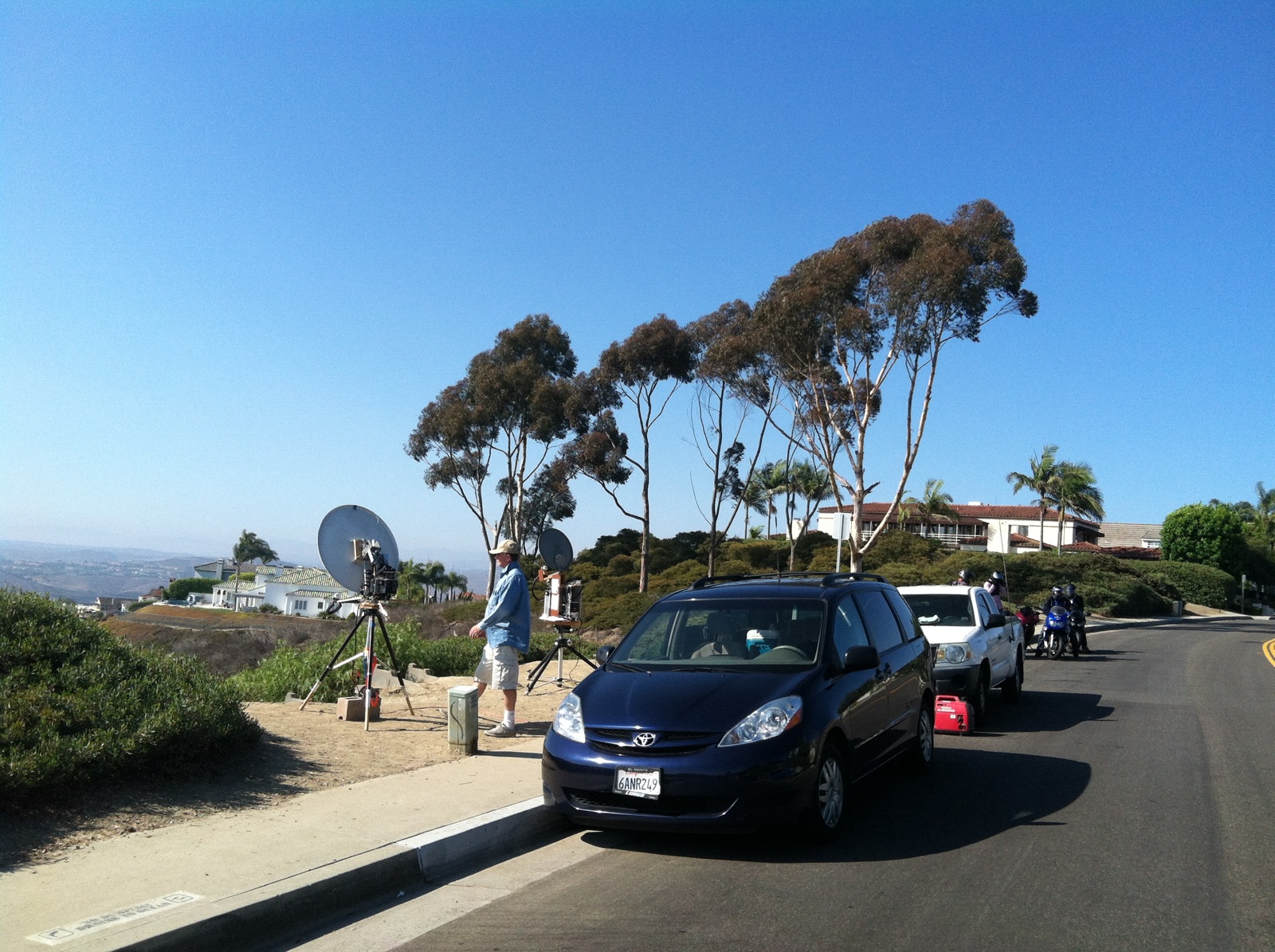
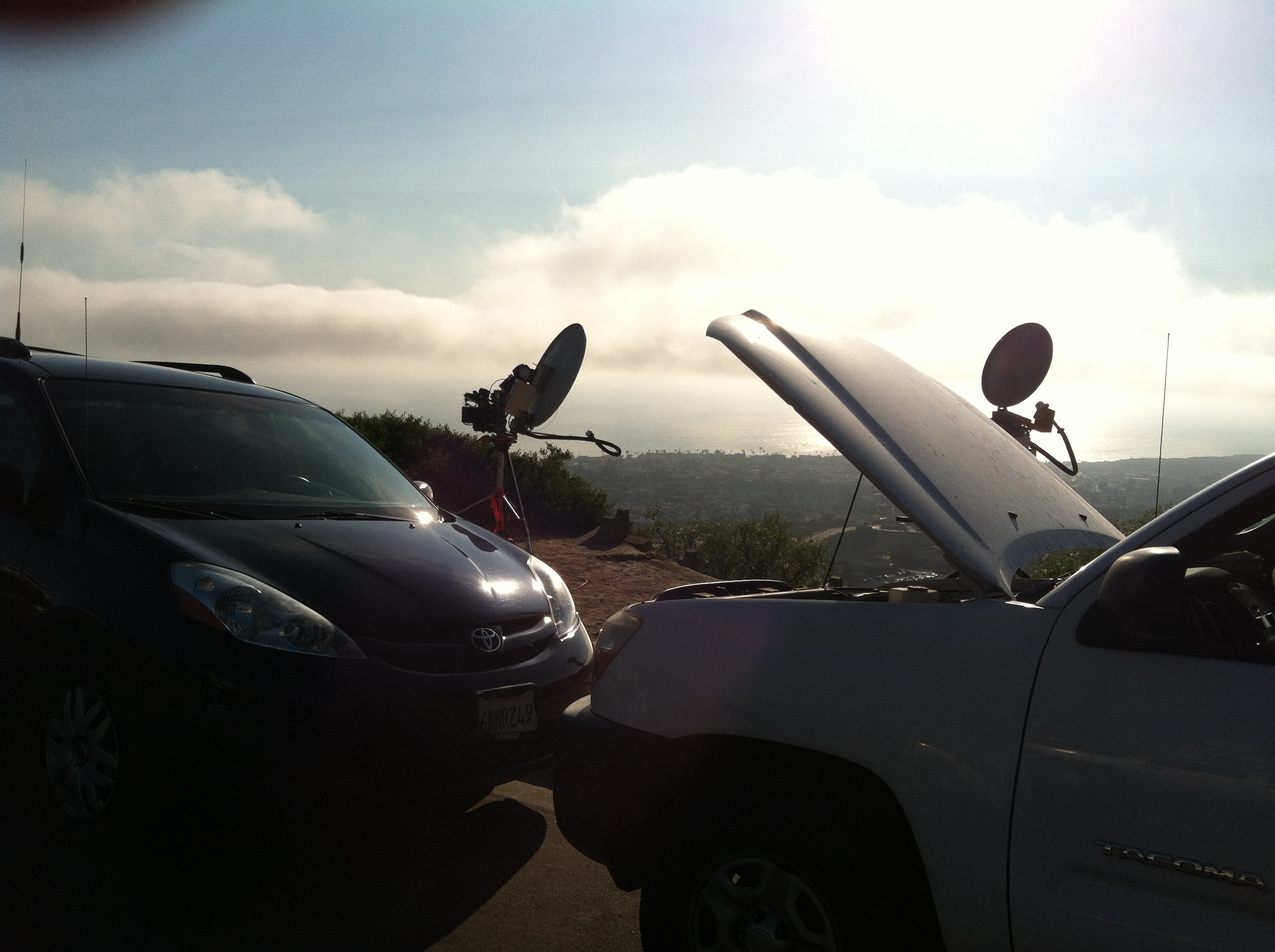
DM03xq Huntington Beach, with views of Palos Verdes. Here we are working N9RIN
back at DM12ju by pointing different directions (one direct, one reflected from
somewhere).
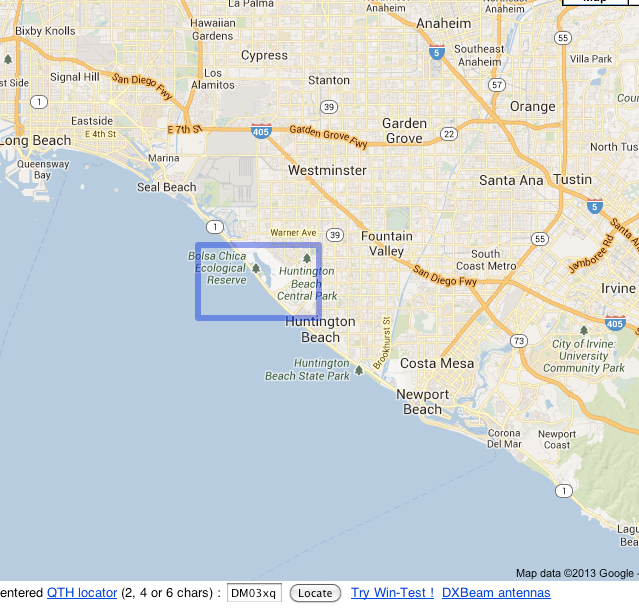
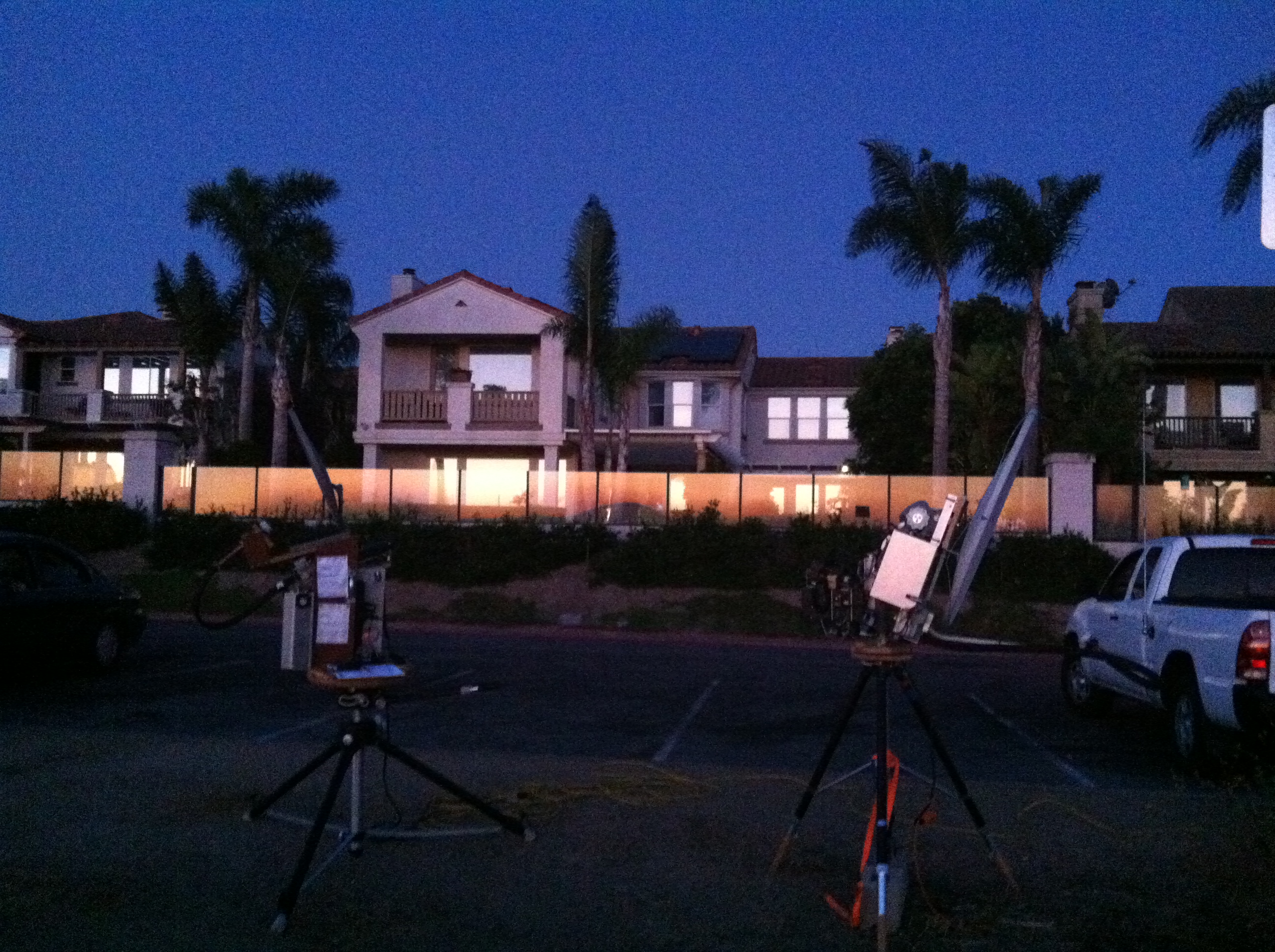
By the end of the day we'd figured out how to load the BarStool in the truck
effectively and somewhat efficiently. Went off to Fish Camp to wrap up the day and make
future plans.
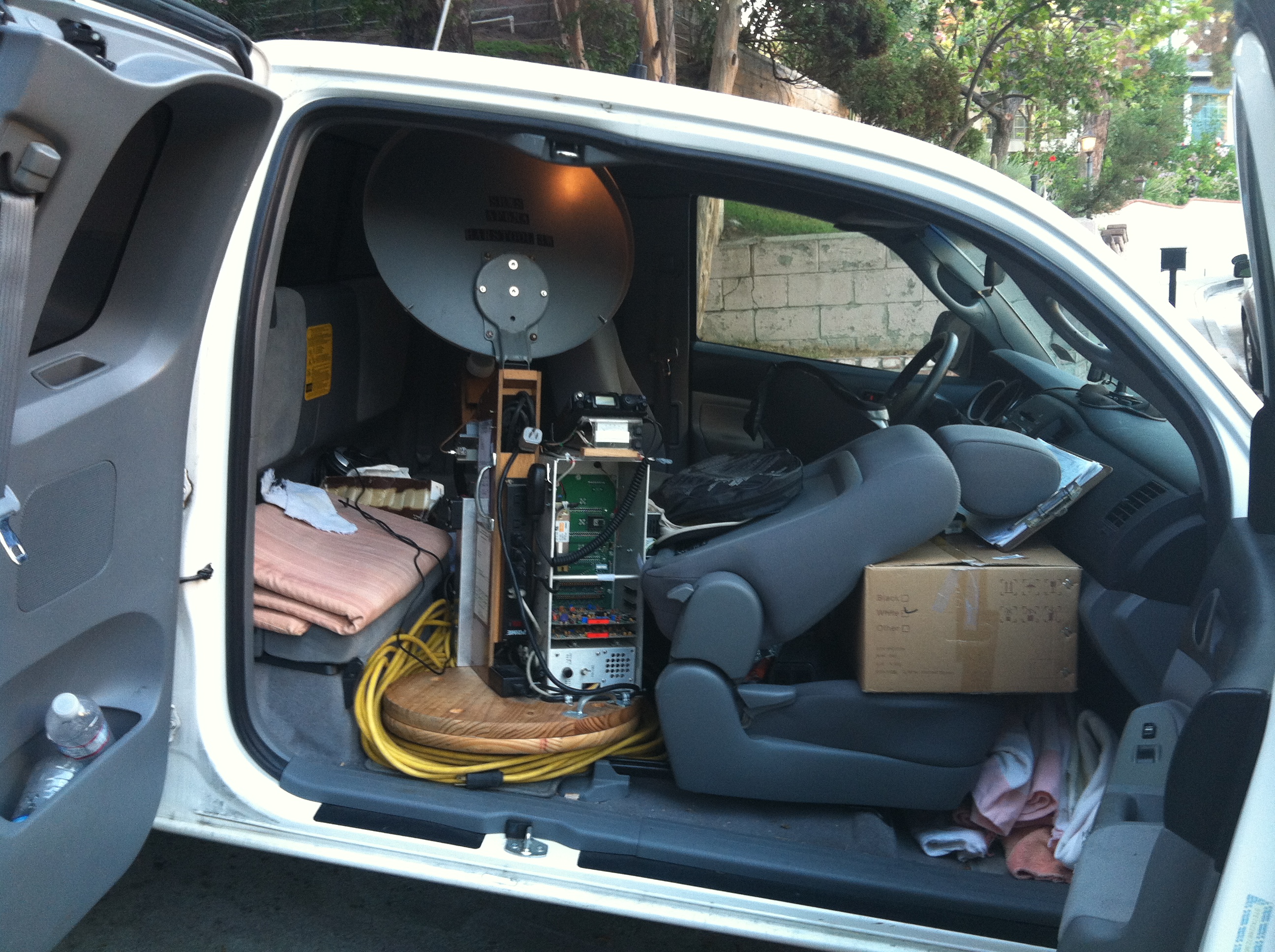
I did not participate in day two of weekend one - 2013 August 18 Sunday
Also, see the report at http://www.ham-radio.com/sbms/newsletters/2013nwsltrs/09sbms2013.pdf
2013 September 4 X-Band Activity Night with
the Barstool
N5BF activity night report.
PV beacon 59+40
Santiago S0 off PV, S1 off some Verdugo west of me. Receiver is OK.
Pointing at PV, put my carrier on .100 at 2052-2054 per schedule.
Hit the wrong button and ID'd on 10,080.2 (144.2) instead of 10,368.1 (432.1).
At least it's in the ham band, if it gets out at all way down there.
No contacts.
2104 heard some USB not well enough to make out on .100
2105 heard N6NB pointing west (S1 but Q5 to me) working AF6NA on .100. Did not
hear AF6NA or any other station.
Tried to tailend N6NB a couple of times, first on USB, then CW. NIL.
Nothing else heard.
Called 'CQ X' on CW, 3x3, every two or three minutes until 2130 then went QRT
and secured.
Warmed my hand in front of the key down feed. About 3 watts worth.
Transmitter is OK.
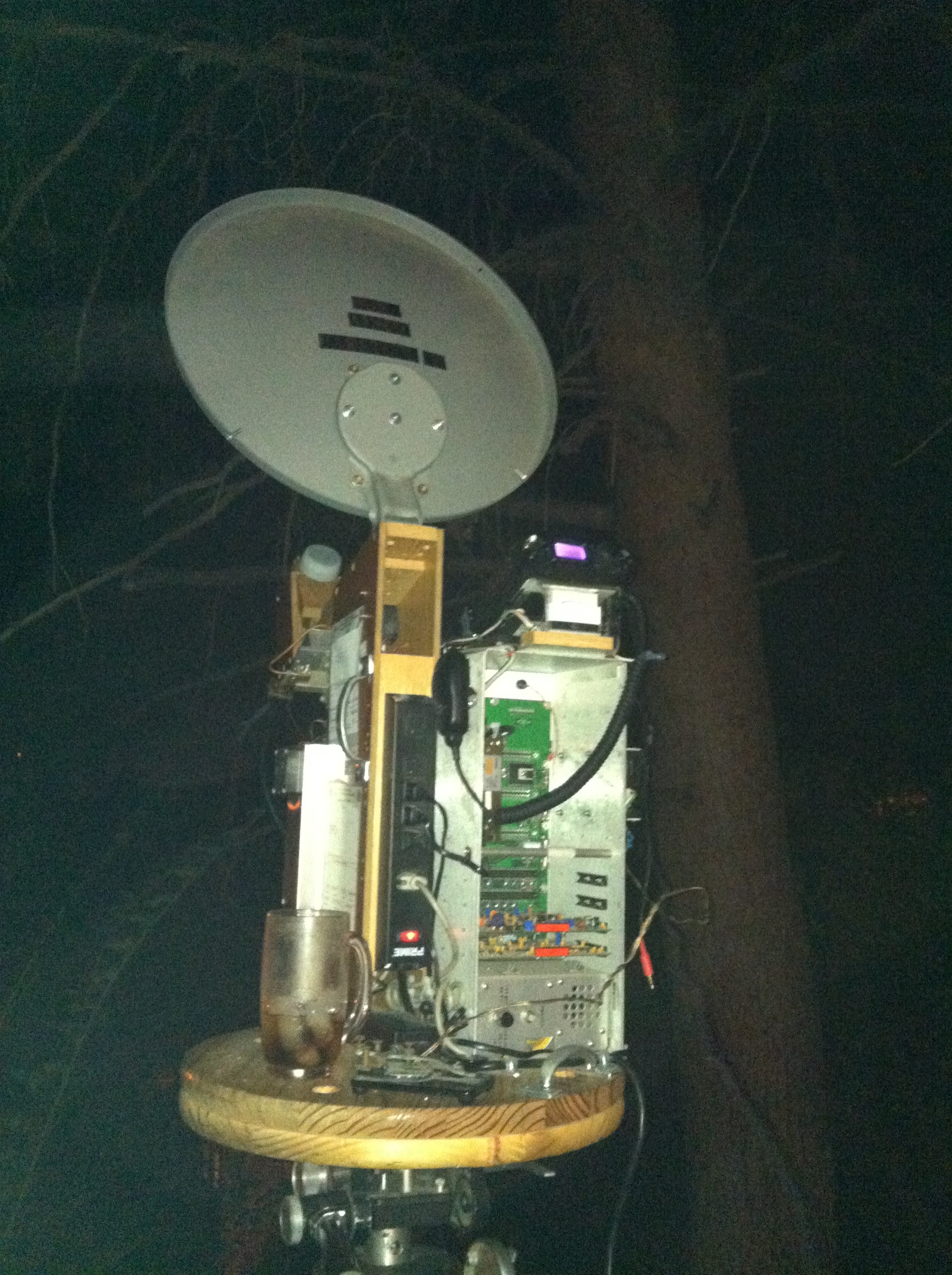
2013 September 21 - Saturday of the Second 10 GHz Weekend of
2013
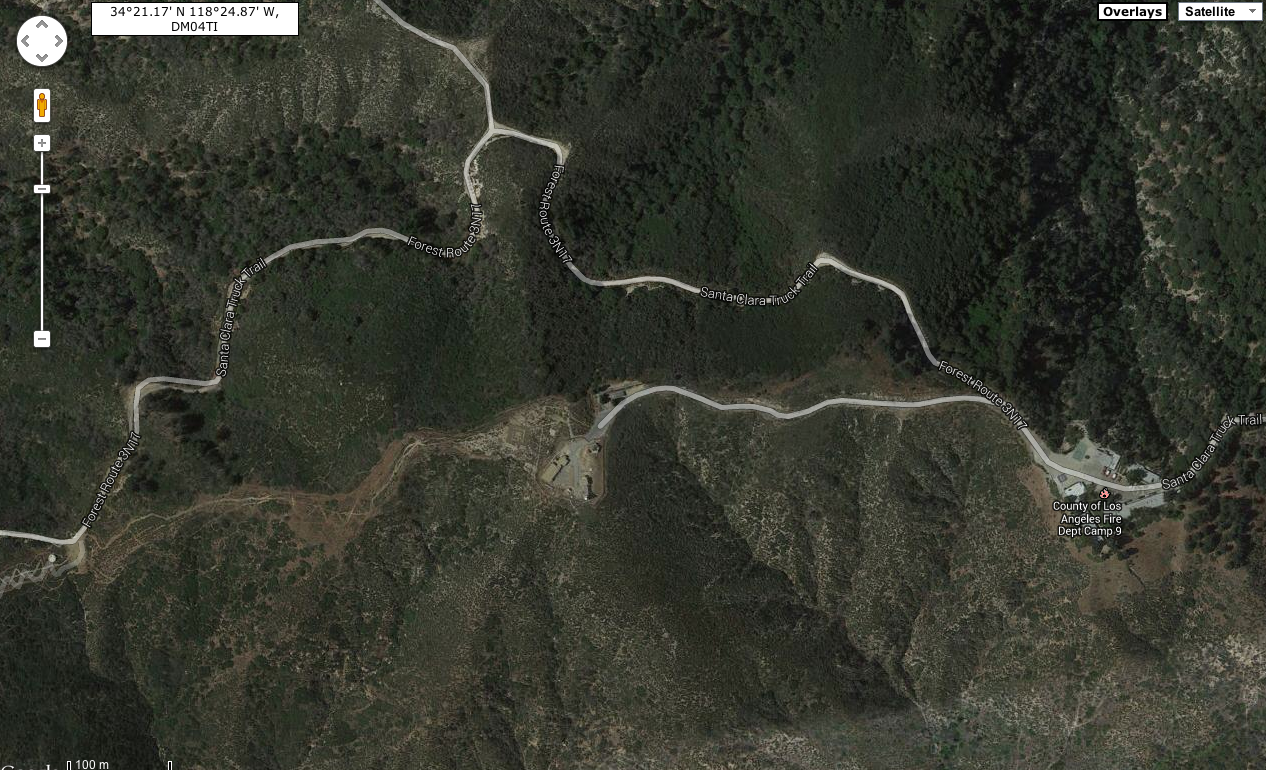
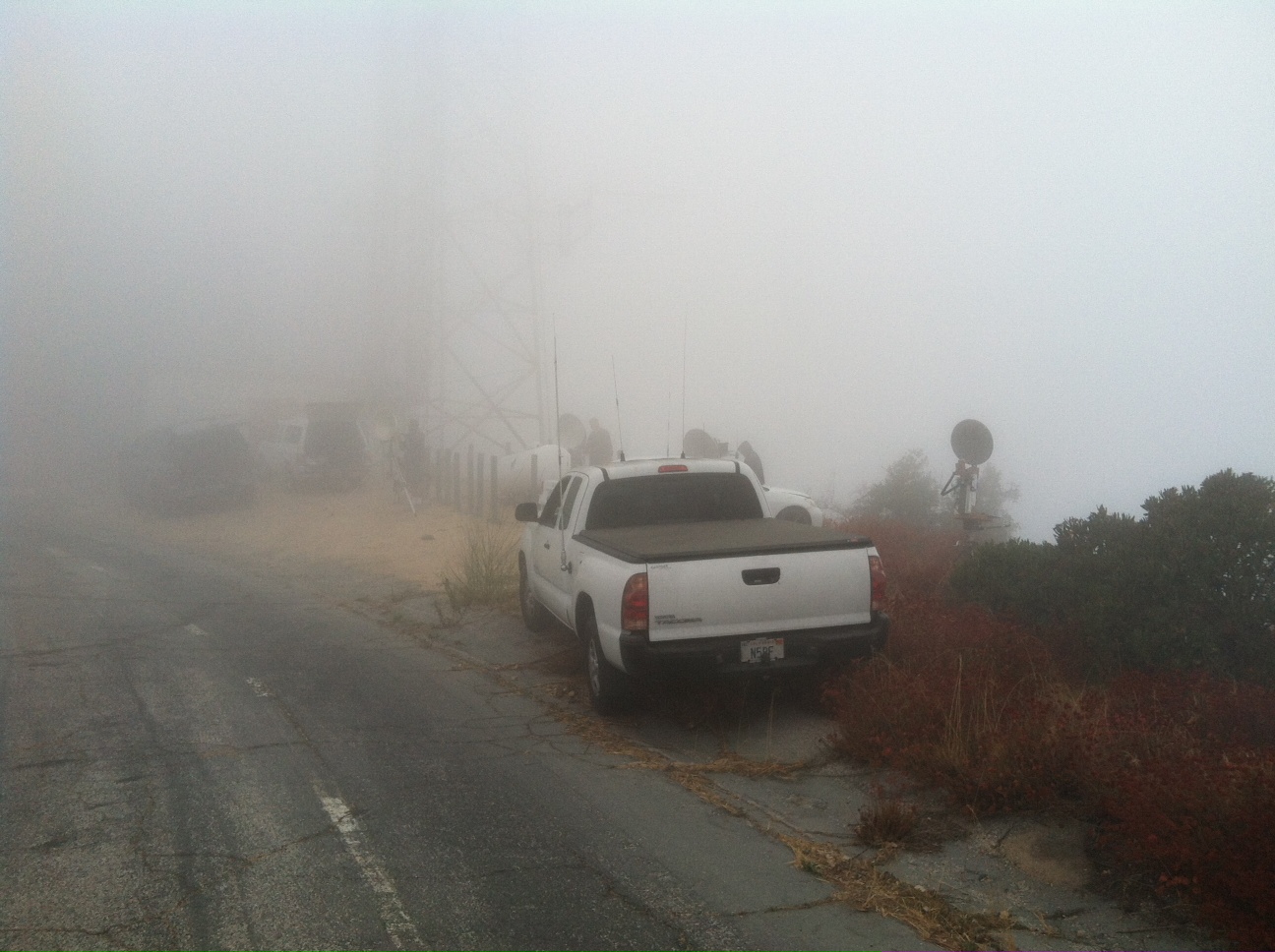
Shared a forest service site near a fire camp with N6RMJ KE6HPZ, and K6QIW
in DM04ti. Known as "Secret Site 51." Then, right before the XE2 came on I left
solo for another site in DM14di up on Blue Ridge.
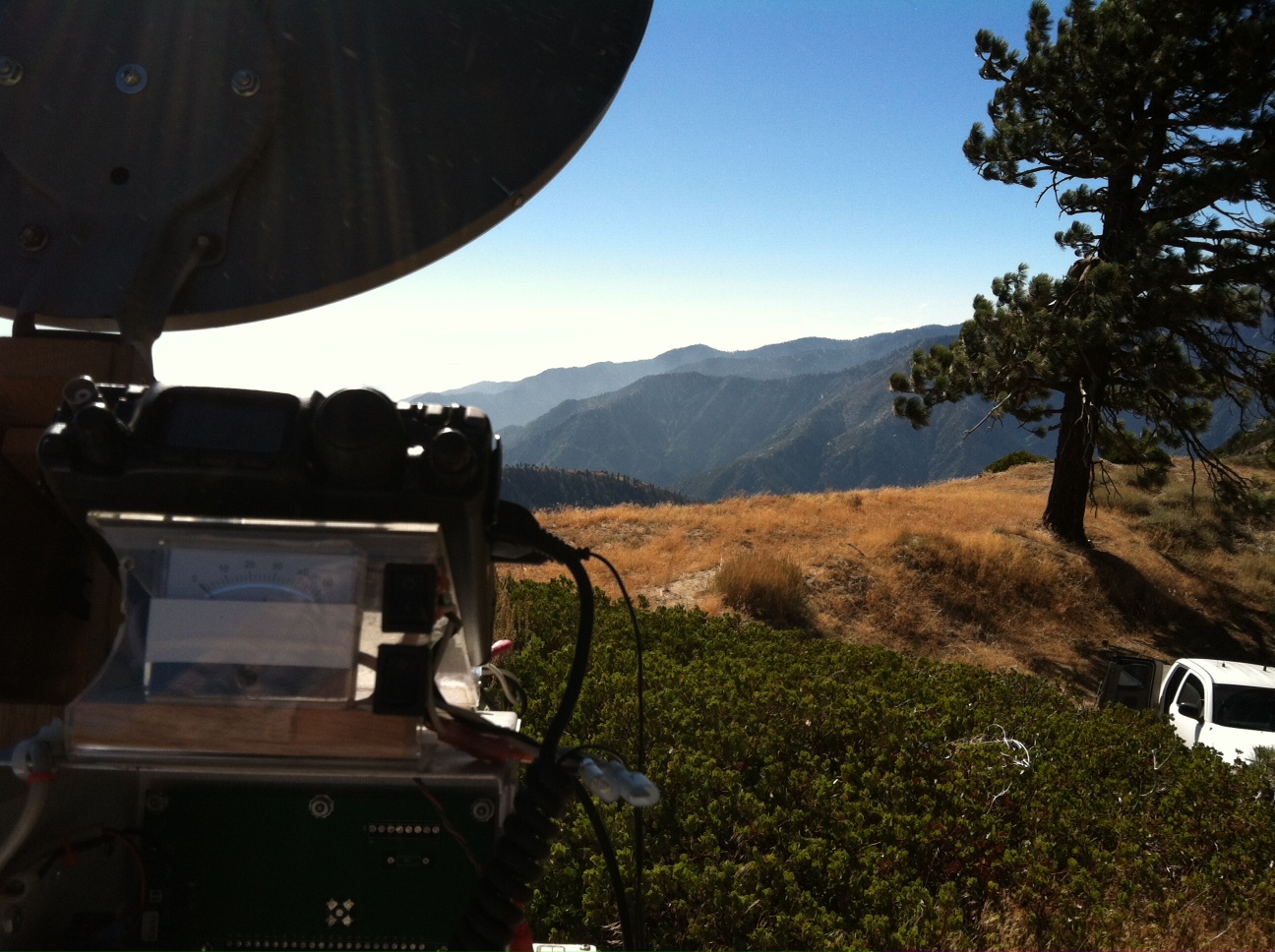
Set up on a sand dune in a high wind using nearly all of my 100 foot
extension chord. Late in the day, I returned south on Highway 2 and joined the
same three operators at the last turnout above La Canada in DM04vf, where the
August 10 test activity had been. N6RMJ now calls this site "Secret Site 2."
Here's the logbook for both weekends.
Unique Callsigns worked: 31
QSO's: 81
Best DX: 427 km
Total Points: 16,699
Operating time (out of 48 hours possible): 10 hours 42 minutes.
This spreadsheet calculates distances from grid square reports and tabulates
distance points, QSO points, and time on and off.

2015 February
Cleaning out a storage at work shared by the radio club W6VIO and the
defunct astronomy club, found a couple of telescope tripods that seemed usable
for a 10 GHz rig. Gave them both to Brian AF6NA and he used one of them to
start building me a rig based on an 80 cm offset fed dish. Here it is receiving
it's first geometric focus in AF6NA's garage.
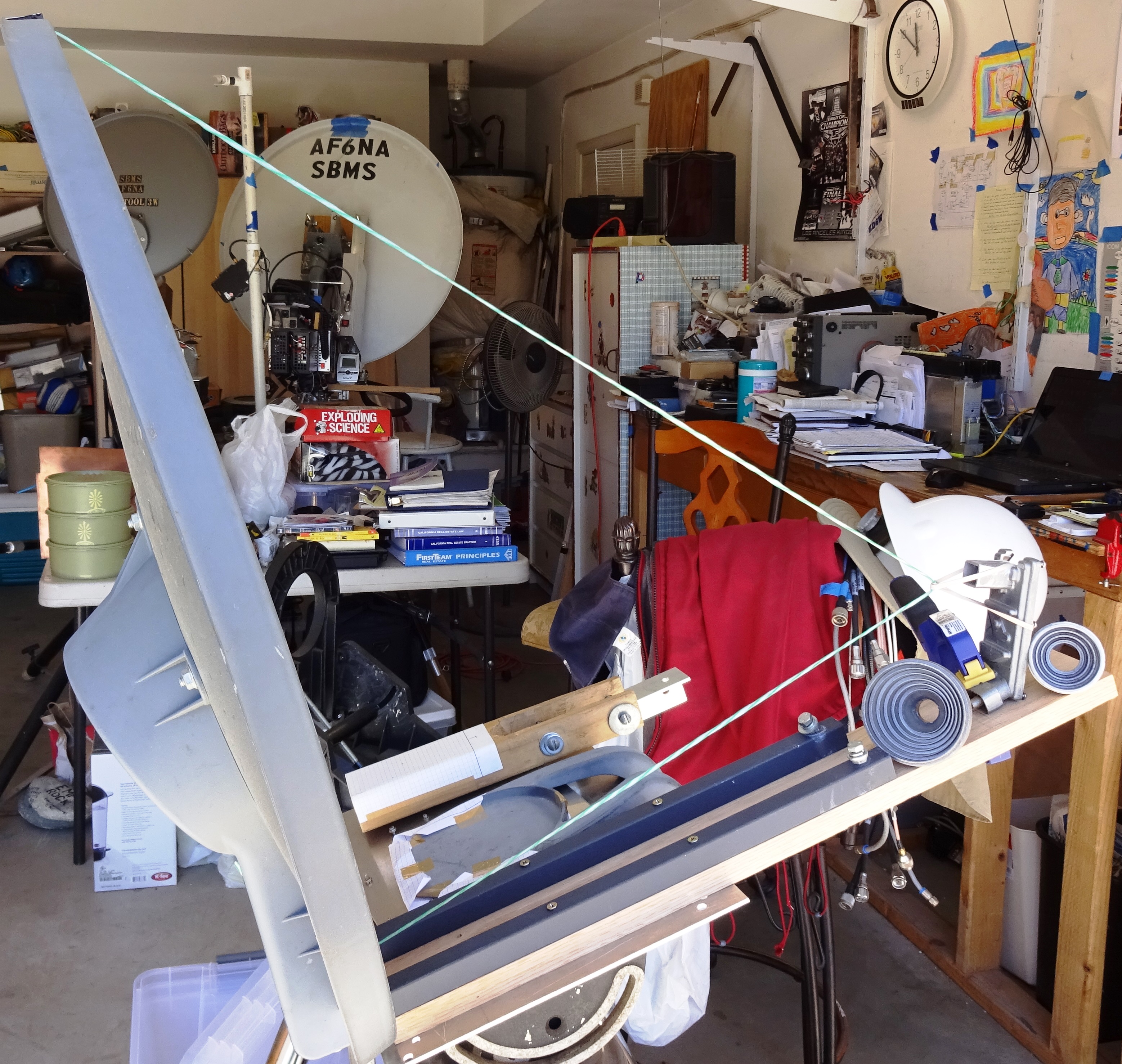
2015 May
Meanwhile, I bought a transverter from Kuhne Electronics DB6NT in Germany at
a very favorable exchange rate and a surplus Rubidium oscillator from China on
E-Bay, some dedicated power supplies from DigiKey, and a custom 10 GHz omni
antenna by W6DFW (SK) that I had bought direct from him some time ago in
anticipation of this. Combining these with the Yaesu FT-817 that I already had,
I drove up into the nearby mountains, set up a card table and did a
receive-only test.
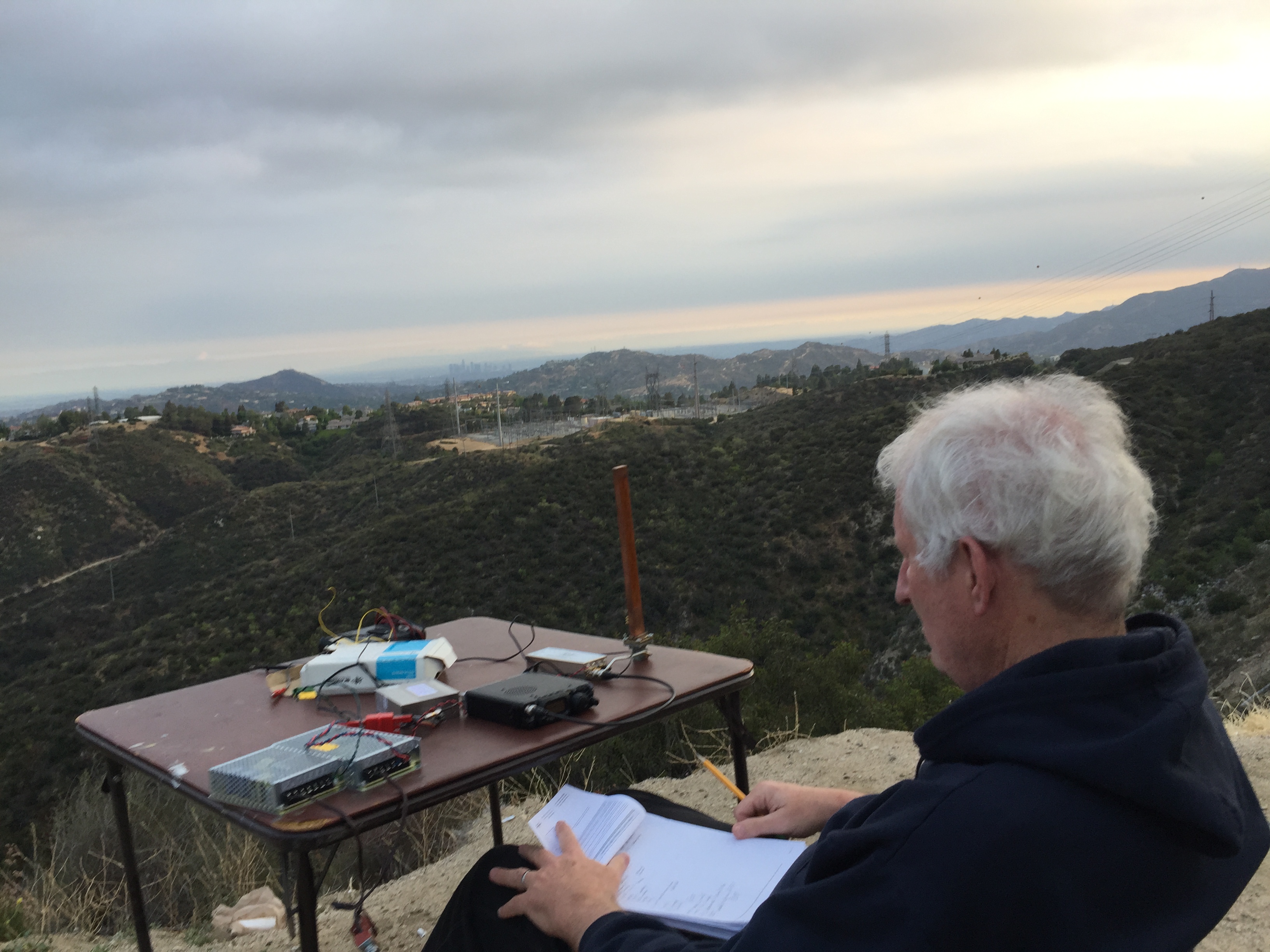
2015 July
Took delivery of the antenna assembly from AF6NA and put on all my Khune
equipment. Tried it out in the back yard then went off to the SBMS annual Tune
Up party in Costa Mesa.
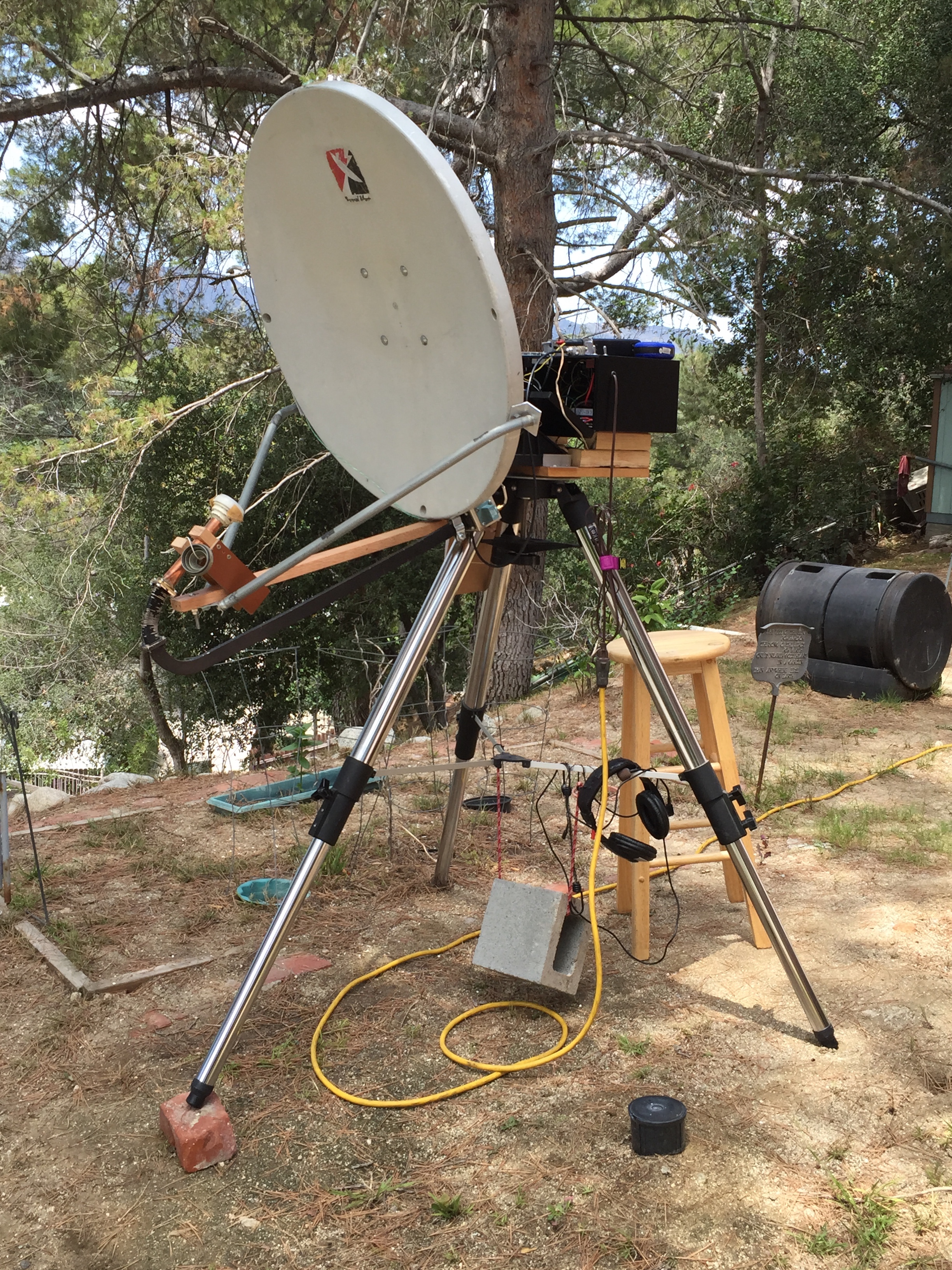
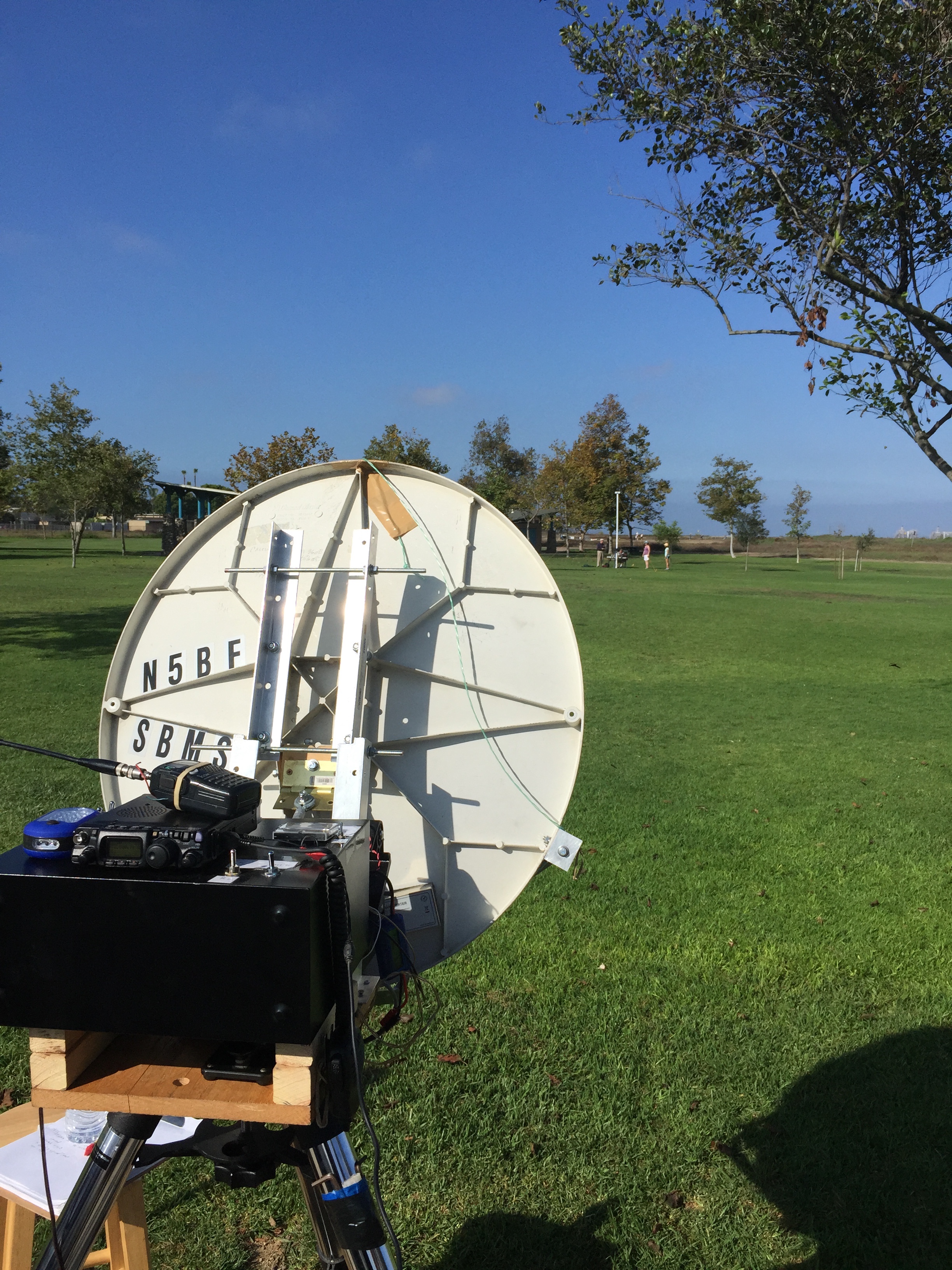
2015 August ARRL 10 GHz and Up Contest Weekend
With everything working "well enough" it was time for the actual contest. I
decided that with this nice, new rig it was time for me to visit Frazier
Mountain, one of the most popular and accessible microwave sites in Southern
California.
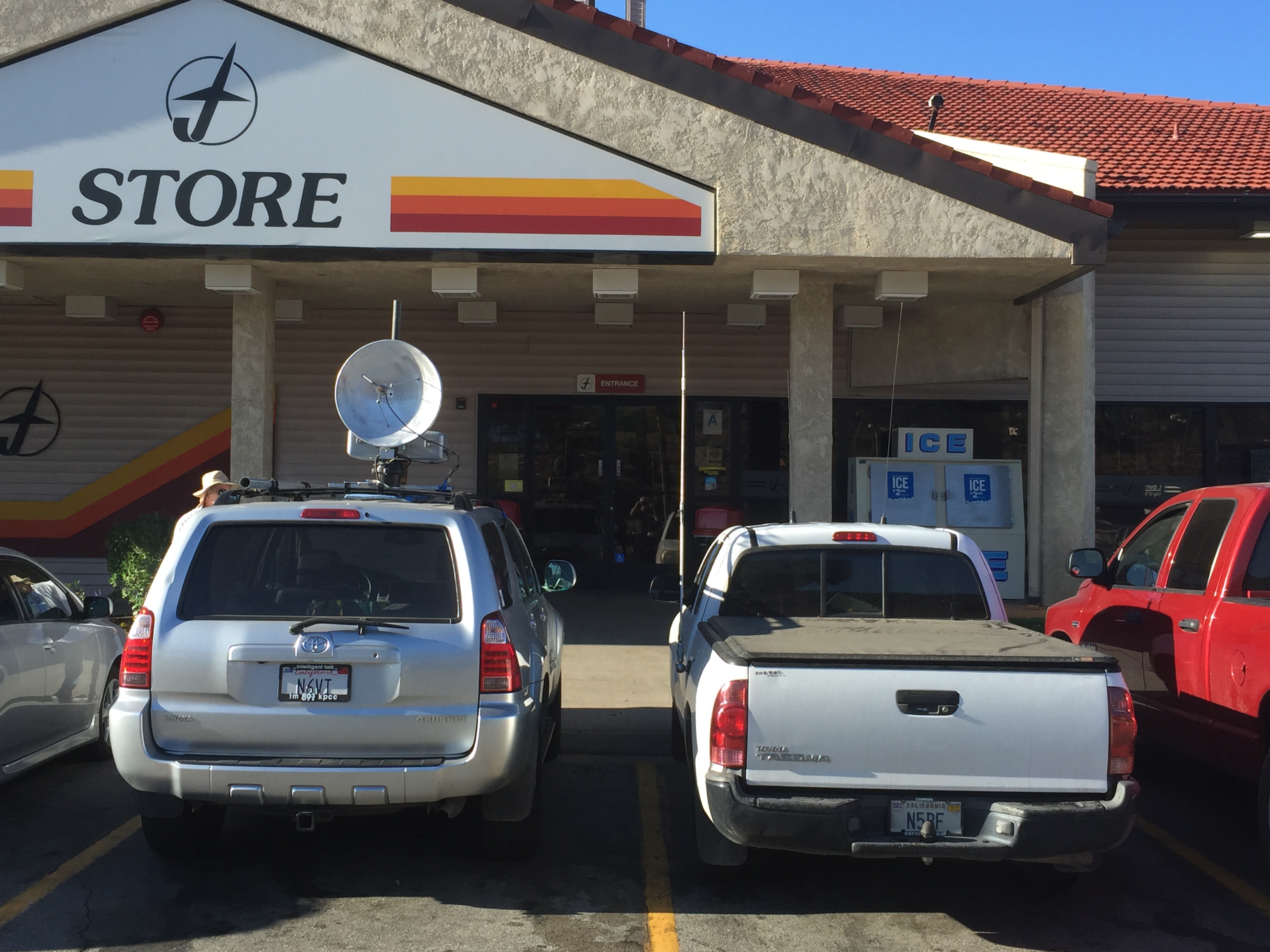
Marty N6VI was good enough to meet me just off I-5 in Frazier Park to lead
me up to the radio site at the top of Frazier Mountain (8013 feet MSL) where
all the operation occurs.
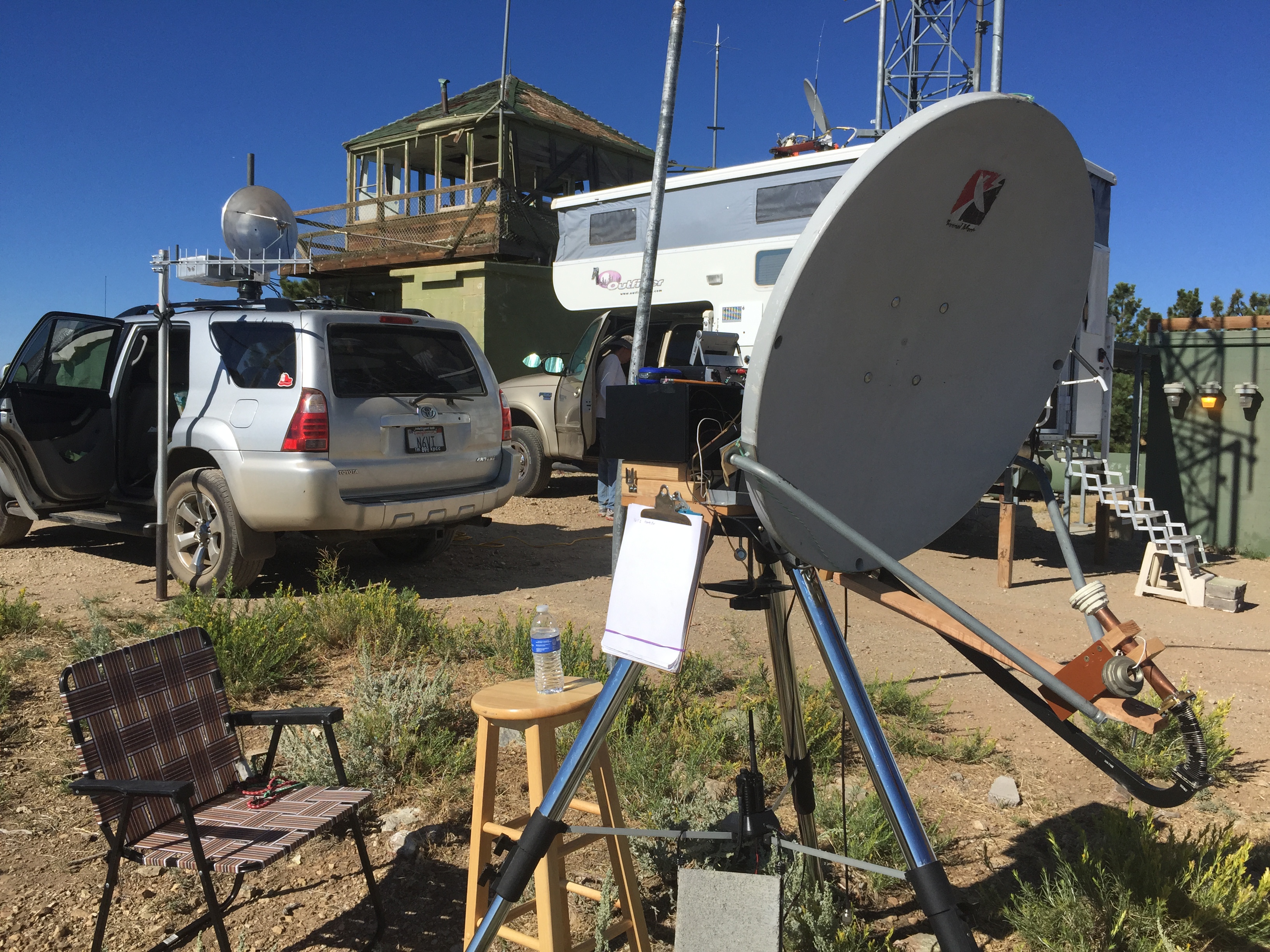
View of N6VI, N5BF, and AA6IW setups on Frazier and tha abandoned fire watch
tower, DM04ms.
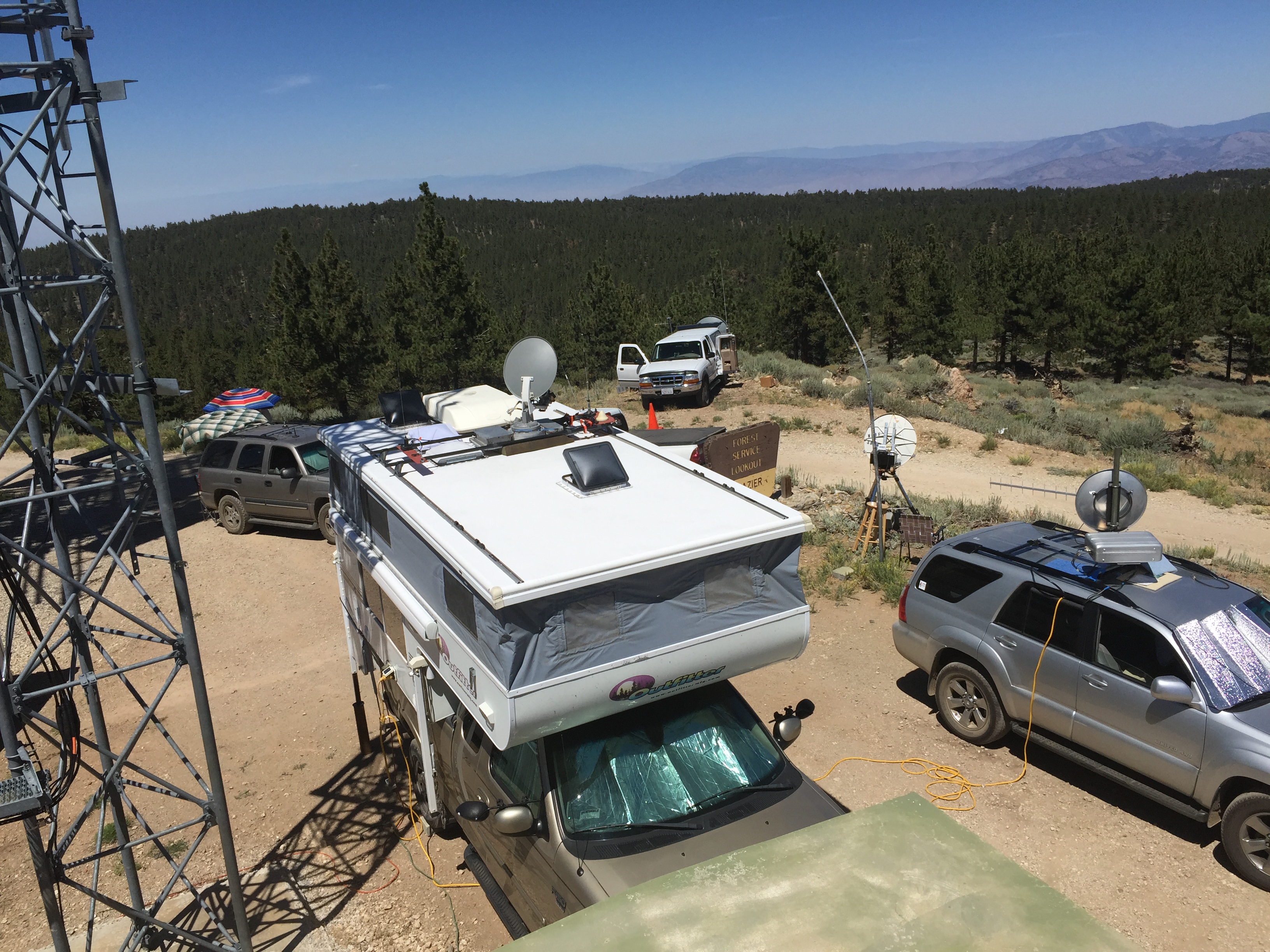
View of KE6HPZ, AA6IW, K6GZA, N5BF, and N6VI setups from the fire watch
tower.
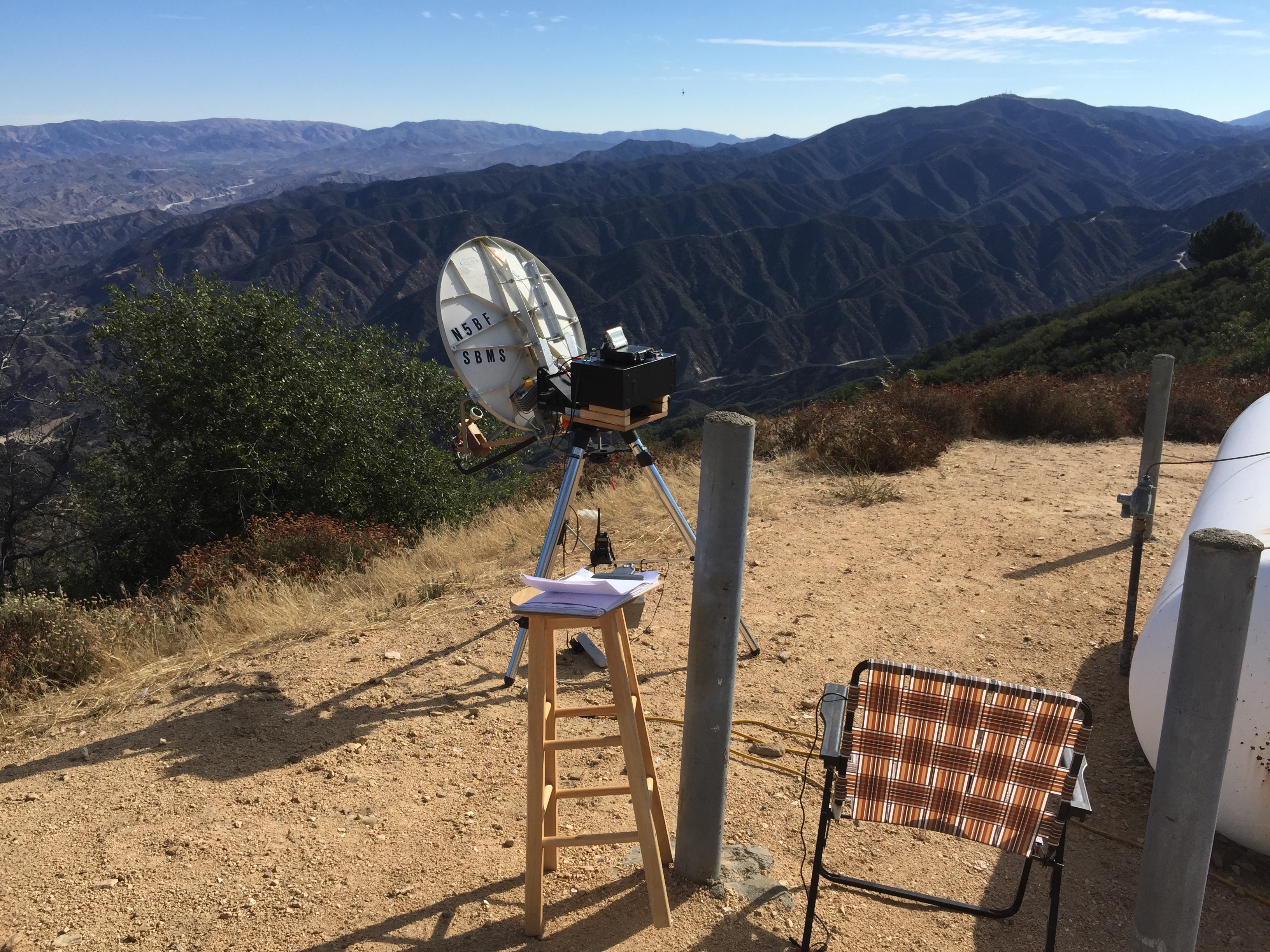
N5BF on Secret Site 51, DM04ti.
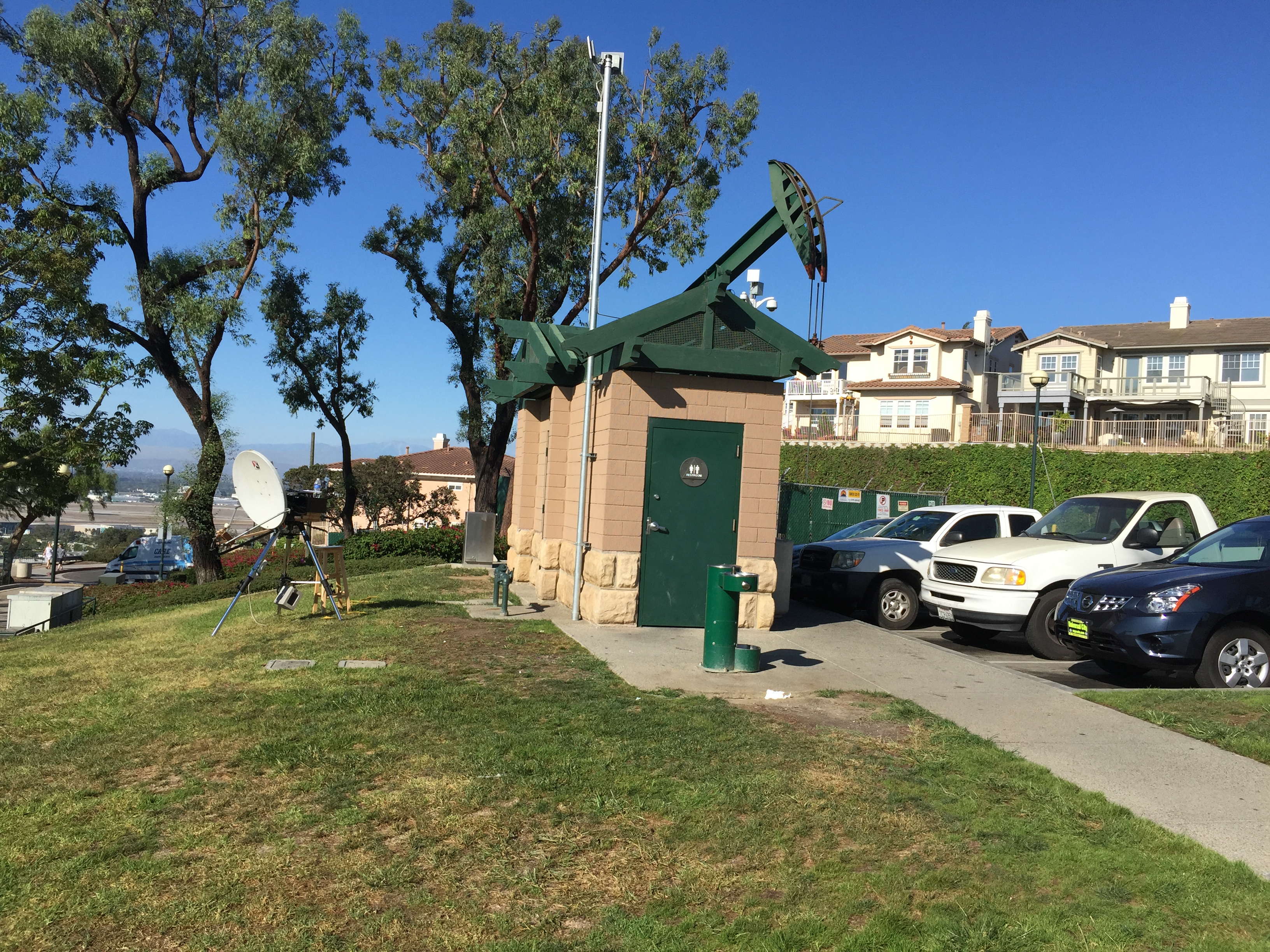
N5BF on Signal Hill, DM03wt.
Additional pictures and writeups of this weekend are in the September 2015
SBMS Newsletter:
http://www.ham-radio.com/sbms/newsletters/2015nwsltrs/09sbms2015.pdf
Following the weekend there was an online discussion about the use and
utility of CW on the microwave operations to which I contributed this:
I’ve been, and enjoyed being, a CW hound from the beginning, have
an ARRL 35 WPM Qualifying Run Certificate (hand copy no less), taught one of my
daughters (who has little interest in such things) enough CW to pass a test in
only 48 easy 15 minute Koch Method lessons (that’s 12 hours, agreeing
with other methods), and only actually enjoy doing the CW running of the
November Sweepstakes (a “static crash bands” contest for those of
you who don’t get down there much) as opposed to the phone, which just
seems to me like a lot of hoarse yelling. I feel charmed to have lived in (at
least at the end of) an era when the people and the technology worked together
in a ways like this to get important jobs done.
That said, we all bring what we have to each event and we don’t
bring what we don’t have. Some of us bring big antennas, some small.
Some have lots of power, some QRP. Some have computers, some use eyeballs,
ears, and dead reckoning. Some have references that stay nearly on frequency,
some don’t. Some have 4 wheel drive to get to the really
“good” places, some stay at home. It’s disappointing to
miss those QSOs because I or the other guy doesn’t have that one more
thing that would put the signal 3 dB out of the noise instead of 3 dB under it
at that moment, but that’s just the way it is.
It was arduous for me to learn CW too but I was motivated. Growing up
poor, we were encouraged, indeed, required not to just solve problems with
money (like a bigger amplifier or tower) but anything you could do to improve
yourself, like learn a new skill, was highly encouraged. It took me a long time
to get fluent, but I improved faster than some of the older people who were my
on-the-air Novice buddies, and am glad now that I did it as a teenager.
The other thing is about CW SS. In mid contest, after the chaos of the
beginning but before everybody is worked out so it’s just people calling
CQ everywhere, I can get into a zen-like state, working one after another,
enjoying discriminating the tones and fists and hearing my callsign sent by
others time after time. If my station would support it I could run a 90 QSO per
hour rate comfortably for 2-3 hours (although I’ve never done more than
75 / hour for 15 minutes with my modest station here).
The microwave contest is quite different. It is situation limited (as
opposed to rate and ionosphere limited) and encourages patience over distance.
My average rate over the weekend was “about 75” / “about
19 hours” which is “about 4 / hour”. I haven’t done
the log yet so I don’t know the actual initials and points and things,
but I know it is already more than I made in both weekends two years
ago.
Geeky as it is, I’m proud and glad to be in a community that does
things like this and appreciate each one of you who went to any trouble (and
the amount of trouble people go to varies over about a 60 dB range!) to put
signals on 10 GHz and above this last weekend. We’re out there
preserving and advancing the state of the art and learning useful lessons,
often the hard way, personally and as a group. I’m already brewing up
secret sauce to bring another dB or three to the September weekend and hope to
(at least make an heroic effort to attempt to) work you all again when it
finally gets here!
73, Courtney, N5BF (often heard as: Bravo Foxtrot!! Bravo Foxtrot!!
Bravo Foxtrot!!)
Next, September 2015 Weekend.
2015 final 10 GHz score:
40792 points - 10th place overall
191 QSOs
47 unique callsigns
615 km best DX
Created 2013 October 26 - cbd
Last Updated 2017 November 26 - cbd
(c) Courtney Duncan 2013, 2014, 2015, 2017


















